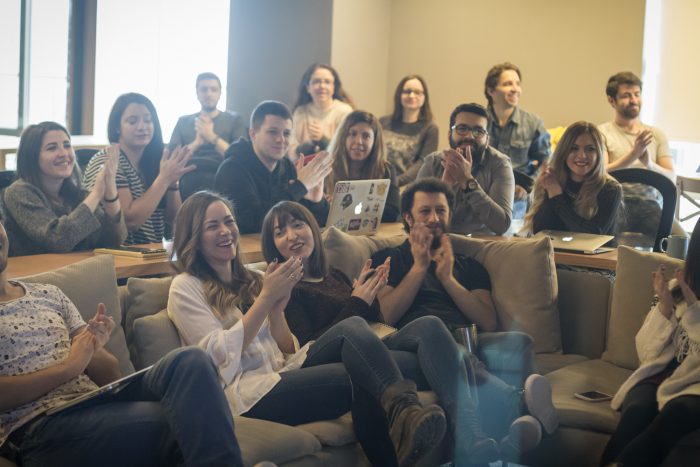3,053 words ~ 10 min read
The power of culture

How to hire and attract amazing people
Before Amazon bought Zappos.com for $1.2 billion, the online shoe retailer was already known for two things: exceptional customer service and a vibrant company culture.
As CEO Tony Hsieh once said, “Zappos is a customer service company that just happens to sell shoes.”
Zappos empowers its call center staff to make emotional connections and to wow their customers in every interaction.
That explains the service-driven reputation.
But how do you create a strong, healthy culture — especially as your company grows?
Well, Zappos defined 10 core values that guide the whole organization. It’s their hiring process, though, that really stands out.
Zappos has two different interview types. The first explores the candidate’s abilities, experience, and team fit. The usual stuff.
Next, the HR department does another round, purely to evaluate culture fit. As Hsieh told Forbes back in 2010, you have to pass both interview types to get the job:
We’ve rejected many talented people who we know would have made an immediate impact on our top or bottom line. Because culture is our number one priority, we’re willing to give up short-term profits or revenue growth to make sure we have the best culture. In fact, after orientation we offer people $2,000 not to work at Zappos. The ones who stay are right for our culture.
Also, when an applicant flies in for an interview, the company sends a shuttle to the airport. Zappos leaders will later ask the driver if the person was nice, or if they were rude or standoffish.
No matter how talented the candidate is, rude people never make the cut.
Talk about living your culture — and your values.
As I’ve grown Jotform from a solo venture into a company with +300 employees, I’ve learned a lot about culture.
I’ve made some mistakes, too. That’s why I admire culture-driven companies like Zappos, Southwest Airlines, and Warby Parker.
I’ll spare you our big mistakes, but here’s what I know for sure about hiring great people and nurturing a healthy startup culture.
Ambitious companies attract ambitious people
“Talent is the multiplier. The more energy and attention you invest in it, the greater the yield.”
- Marcus Buckingham, author and business consultant
It starts at the roots. Whether you’re selling airline tickets, eyeglasses, software, or burritos, you need to have a great product.
After all, talented people want to work in organizations that make an impact. They want to change the world — even just a little. And there are many ways to become world class.
There’s a terrific restaurant near our office that changes its menu every month. If you’re an ambitious, creative chef who’s hungry to learn, this is where you want to land.
Even if you provide a “boring” product (like, ahem ahem, web forms), your approach could make it an amazing place to work.
Take Jotform. Our +10 million users live in 192 different countries. We practice continuous improvement, our teams have unmatched independence, and our employees get to really flex and apply their skills. We also hate bureaucracy.
This isn’t an ad; I simply want to illustrate how ambition and impact can take different forms. And I’ll be honest. Even if you do have a great product, it’s still tough to find and hire the right people.
Nurture a healthy and supportive culture

If you are lucky enough to be someone’s employer, then you have a moral obligation to make sure people do look forward to coming to work in the morning.
John Mackey, CEO, Whole Foods
Culture can be a major asset. It helps you to attract top-notch people and encourages them to stay for the long run.
I know that’s easy to say, but how do you actually do it? I believe in two core elements:
1. Ensure a comfortable work environment
Make sure your office is a place you and your team want to spend time in, even if it’s small. Equip staff with powerful technology, up-to-date equipment, and all the tools they need to work safely and efficiently. Free drinks and snacks don’t hurt (but you don’t need the ping-pong table). All these details are also cheap to provide, relative to employee salaries. Don’t cut corners on your most valuable asset.
2. Always choose positive, collaborative people
I know it might sound simple, but having smart, friendly, talented, positive people lays the foundation for your culture. Good people attract more good people, and you’re also promoting an inspiring work environment. Nothing will send people running for the door faster than a culture of infighting, gossip, and petty competition.
Leverage good word-of-mouth
You’re scrolling through Instagram. In one post, your friend tags a hotel they love. The next post is a sponsored ad for a competing hotel brand.
Which are you more likely to remember and try for yourself?
Real endorsements from our network are powerful. If you love your job, company, or work environment, you’re likely to tell friends and family.
We post our job openings on LinkedIn and online job boards. We’ve also used headhunters for leadership positions. But nothing works better than word-of-mouth.
When valued employees refer their friends and former colleagues, we pay close attention. These are often our best candidates.
We also have a large paid internship program. At the college job fairs we attend, students can immediately apply (through a web form, of course) to join us for the summer, or during a school break.

This way, they get to see our product in action and learn more about the company. In 2020, we’ve already had over 1,500 applications.
Thanks to people who generously spread the word, we’re able to attract lots of candidates and choose the very best.
Interview efficiently and decide quickly
According to a recruiting survey by the National Association of Colleges and Employers, employers hiring new college graduates take, on average, two weeks to make a job offer after an interview.
Beyond new graduates, author and HR expert Liz Ryan says companies should never take more than 3–4 business days to contact or share feedback with candidates after an interview.
We do it the same day. Often, we call the candidate as they’re walking to their car — right after the interview.
If you don’t move fast, there’s a good chance someone else will snap up a great employee. Forget about waiting periods or outdated rules and do it your way.
How is it possible to move so quickly?
Well, we believe in having all the decision makers in the room. Everyone has the chance to observe and ask questions.
After the interview, we have a five-minute discussion. If it’s a long debate, the person is probably not right. But a quick, easy consensus usually means that we’ve found a great fit.
Hire for skills and knowledge
Knowledge and skills are not the same.
Whatever position you’re hiring for, ask the candidate to perform a hands-on task. Over the years, we’ve encountered both “developers” who can’t actually code and dark horses who performed far beyond our expectations.
It’s equally important to talk with the applicant about their chosen field. Can you have an intelligent discussion? Do their ideas and arguments make sense?
Sometimes, people speak in buzzwords but they don’t have real knowledge. They’ve just memorized headlines and jargon.
Ultimately, it’s a matter of balance. Candidates need to have some real skills (and that level will vary by position), but the right person can also acquire what they’re missing.
The same goes for knowledge. Young employees will gain deeper expertise over time, but if they’re truly interested in the topic, they will already have opinions about marketing or data science or design.

One more note: Watch for people with side projects. If a developer has their own app, for example, that’s a great sign. It means they’re ambitious and engaged.
In different fields, this could also be a blog, a podcast, a passion for reading, participation in a professional group, or taking extra classes and workshops.
Culture is always in motion
Leadership is absolutely about inspiring action, but it is also about guarding against mis-action.
Simon Sinek, author, speaker and marketing consultant
Company culture is like the infinity symbol, or the old chicken-or-the-egg dilemma.
Which comes first: great people who establish a healthy culture, or a healthy culture that attracts great people?
Answer: it doesn’t matter.
People talk about culture as a static entity, but it’s constantly changing. Culture also has its own equilibrium. Sometimes it evolves for the better, and sometimes it needs to be nudged in a better direction.
Internal culture is a topic that can easily fill entire books, but here are my top lessons.
Culture changes as you grow
Our first 10 employees were men. That wasn’t my intention. It just happened, but then I learned about this mistake and realized we needed to attract more women. As the balance (happily) shifted, our company became more professional, just to name one improvement. Change made us stronger. These are the kind of culture shifts that organizations should always embrace.
People influence the culture
Let your staff contribute. Our small, cross-functional teams naturally develop their own cultures — and that’s a good thing. They enrich our entire company and make more interesting and diverse place to work.
Don’t enable incongruent behavior
Just as Zappos measured candidates’ humility and openness by talking to their shuttle drivers, it’s important to weed out both people and actions that don’t match your values.
For example, we care deeply about our users and we take responsibility when they make mistakes.
One day, we were watching a usability test, and an employee joked that the user was stupid. I realized that I had to immediately change the narrative, without publicly chastising the employee.
I told the team that we should assume people are busy and overwhelmed. That’s why our goal is to make a simple, incredibly easy-to-use product.
If we had all laughed, other team members would have assumed that it’s okay to mock our users — and that doesn’t align with our values or our culture.
A company’s culture is the foundation for future innovation. An entrepreneur’s job is to build the foundation.
Brian Chesky, co-founder and CEO of Airbnb
While I’ve never offered someone thousands of dollars NOT to take a job, we do believe in humility and we reward learning. I’ll also share a little secret.
Every intern — whether they’re studying programming, marketing, UI, design, or business — spends their first week answering customer support questions.
Throughout this process, they are being rated; not just on their skills, but also on how they listen and treat our customers.
Sometimes, they think support work is beneath them. That attitude overshadows their skills and their knowledge.
And those interns will never have a seat in our company.
Beyond ping-pong tables: how to dodge clichés and build a team you love

It was a Thursday afternoon in May.
Our team had just cycled across the Golden Gate Bridge. We started at Fisherman’s Wharf, then cruised through Presidio National Park and across to Vista Point.
Still catching my breath, I got off my bike and gaped at San Francisco and East Bay in the distance. Tourists were snapping selfies, while everyone high-fived for finishing the ride.
I couldn’t stop smiling. Watching my team laugh and gently tease each other was honestly better than the stunning view below.
When I started Jotform 15 years ago, it was just me and a plan to create simple web forms. I never imagined we’d grow to employ +300 people on three continents and serve +10 million global users.
That’s why our cycling day in San Francisco felt so meaningful. Having fun and enjoying time together is essential to our culture.
I know that “corporate culture” can be a cliché — especially in the hard-driving startup world.
Some companies equip the office with beer and ping-pong tables and call it culture. Other Silicon Valley giants offer over-the-top perks with the caveat that employees will practically live at their desks.
Spending an afternoon on wheels is great, but for us, it’s not the point. We do our best to work in a way that’s sane, open and friendly. We’re not perfect, but we try to keep normal hours and treat each other with deep respect.
That’s culture — and if you’re building a startup or even a team of two, please know that you can nurture a kind and supportive environment.
I believe the secret lies in slow growth.
The tortoise and the hare

Many VC-backed companies receive funding and set off on a massive hiring spree. Once the runway gets short, they’re forced to start laying people off.
I empathize with this situation. If you’ve ever had to fire someone, you know that it’s really hard for everyone.
If you bootstrap your startup, that slow, careful growth can prevent big spikes and drops in your team.
I have a rule that we don’t hire someone unless we have their entire first-year salary in the bank. I followed this rule when Jotform had just one employee and we still adhere to it now.
Growing gradually also enables you to learn what you truly value.
I always remember how Enron (the disgraced former Texas energy company) had four stated values: respect, integrity, communication and excellence. That “official” culture didn’t save the company from a massive bankruptcy and auditing scandal that sent several top execs to prison.
As your company evolves, you can nurture the parts that feel authentic, like an undercurrent of humour or cultivating side projects. You’ll know what’s true (and valuable) and what you want to improve.
The double-digit speed bump
Building culture can feel effortless when your team is small, but many founders find that it gets tougher when you bring more people into the fold.
New offices or locations can also add complexity. That’s when your efforts need to become more intentional — and often more creative.

For the first five years, Jotform had just four employees. It was easy to collaborate and brainstorm. We all worked on the same projects, we ate lunch together, and we went on fun team vacations and retreats.
In our sixth year, we grew to 15, then 28 employees the following year. It was great news for the business, but internally, we were struggling.
Productivity hit an all-time low. Communication suffered. We shared an office, but everyone was tackling different projects.
We had lost our sense of community and collaboration. For the first time ever, I didn’t feel excited to come to work each day.
That’s when I decided to split everyone into small, cross-functional teams of 4–5 people. Each group was empowered to work with flexibility and independence — almost like a little company. We gave also gave each team dedicated office space.
The results were dramatic. By returning to our lean, collaborative roots (despite a growing headcount), everyone was happier. Even the product improved.
We also instituted Friday demo days. These informal show-and-tell sessions ensure that each team stays on track. They keep us all connected and motivated.
Growing slowly enables you to experiment — not only with your products, but with your office culture.
It’s not an exact science. We’re all human, and it can take some time to find the sweet spot.
Don’t rush, listen to your employees, and think about the moments when your team is working in harmony. Then, apply what you learn and keep testing.
Actions speak louder than rules
Culture emerges in the broad strokes, like team structure and transparency. It’s also shared through actions.
For example, if you claim to promote work/life balance, but you stay until 11 pm every night, you’re sending mixed messages. The same goes for work environments.

We all need light, fresh air, space, and places for collaboration and privacy. We’re physical creatures who don’t thrive when we’re crammed into an airless box.
I realize that space can be costly and I don’t share this advice lightly, but refreshed, happy and well-equipped employees will do better work — and your office will be a much better place to spend the day.
At Jotform, we try to walk our cultural talk. We believe a beautiful work space is important.
We give people powerful computers, a fast internet connection, and anything else they need to do their jobs, whether that’s a drawing tool or a course enrollment.
Employees have big desks and freedom to work in a way that maximizes their own productivity. We encourage people to take vacations and we ALL keep normal work hours.
Launch weeks are the exception, but that only happens once a year. When we launched Jotform Cards, we held parties in both Ankara and San Francisco.
It was a fun way to celebrate a year of hard work, but also to connect with our user community.
Meeting and talking to real customers is another big part of our culture, so we try to give our employees the chance to mingle with the people who actually use what they build.
It’s rewarding — and it reminds us all why we’re going to work every day.
Finding great people isn’t easy
Ah yes, hiring.

If you’re a founder or an entrepreneur with even one employee you know how challenging (and important) it can be to attract great people.
You want smart, skilled employees. Like the Norwegian Olympic team, you probably have a “no jerks” policy, too. But it’s not always easy to know how a candidate will gel with your team.
Clarifying your ideal “cultural fit” can help. It’s not foolproof, but spend some time exploring what your strongest teams have in common.
Try to isolate the internal and external qualities of people who consistently drive your business forward. Study your own culture and break down the most successful elements.
If you’re still too small for this exercise, look at products and companies you admire. Read about their journeys and try to learn how they operate.
For example, I’ve noticed that employees who have (even very small) side projects are often standout team members. It shows that they’re excited about our industry, or even about stretching their own skills and creativity.
Given our small team structure, we also need people who can collaborate. Anyone who wants to work in a silo, take personal credit for every small task, or who can’t communicate well is not suited to our office culture.
Test, change and adapt
Every business is different. That’s both an opportunity and a challenge.
After 15 years of growth and change (and a whole lot of mistakes), I’ve learned that culture needs to be intentional.
Like any relationship, it has to be nurtured. It will change and evolve, so it helps to stay open. Be flexible. But also, understand what matters most deeply.
Don’t compromise anything that’s truly essential to your business or your values.
With time, energy and experimentation, you can build a team that makes you feel incredibly proud – both when deadlines are looming and when you’re cruising the Bay Area on a bike.